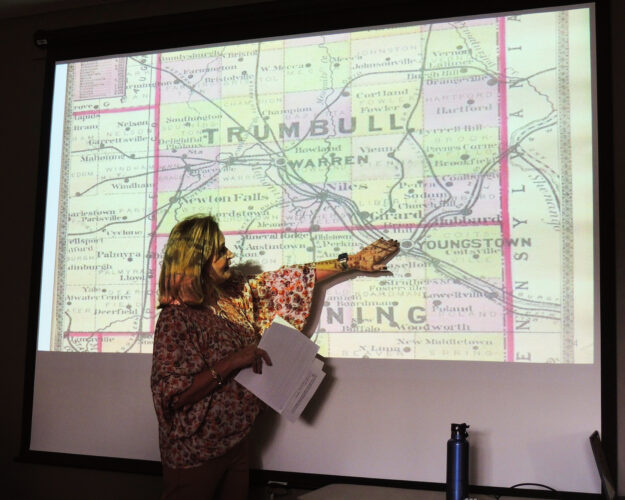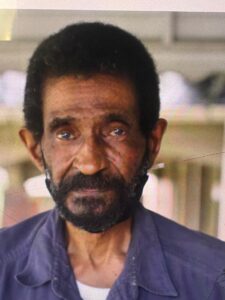Mining some knowledge in Brookfield

Correspondent photo / Nancilynn Gatta
Brookfield Historical Society Secretary Marilyn Yensick of Brookfield points out the route that coal from the Brookfield mines would take to arrive at the Youngstown steel mills. The coal was first transferred on boats through canals but later on trains, which was more efficient. Yensick was one of the speakers on Saturday about Brookfield mines at the Brookfield branch of the Warren Trumbull County Public Library.
These were some of the facts revealed about coal mine locations, the work done there and the lives of the miners during a talk from Brookfield Historical Society members on Saturday at the Brookfield branch of the Warren-Trumbull County Public Library.
Jan Arnaut, vice president of the Brookfield Historical Society, said coal was discovered in the area in the 1830s. She mentioned more than a dozen different mine locations, including ones in nearby Masury.
“There were three different types of mines,” Arnaut said.
“A drift mine, which has a horizontal tunnel dug into the side of the mountain for access to the mine. A slope mine uses a tunnel to access the mine and the third method is a shaft mine, which is the deepest in the mountain. There were two shafts dug. One transported the miners and supplies down into the mountain and the other brought the coal up to the surface.”
The slope was in the middle of the mountain and the drift was at the highest point.
The miners were immigrants, many from Eastern Europe and England who sought a better life for themselves and their families. However, that was not always what happened.
“Mine owners would build the town with company housing and stores and then bring in the workers. They would pay them with Scrip, a metal coin that could only be used at the company stores. Workers could not purchase items outside of the town. This prevented them from getting ahead (in life)”, Arnaut said.
Carol Novosel of Sharon, Pa., had a personal story about the immigrant experience of working in the mines.
“My (maternal) grandfather, Basil Kulczycky, came from Western Ukraine. Representatives from the mines would go there and conscript workers. He worked in a Clymer, Pa. mine, but there were too many accidents so he came to the Brookfield area mines,” Novosel said.
She displayed his birdcage, which housed a canary. He brought it into the mine when he worked. If the bird stopped singing, it was a warning to the miners to leave because there was a poisonous gas leak.
Marilyn Yesnick, secretary of the Brookfield Historical Society, talked about the use of children in the mines who were known as The Breaker Boys.
“My great-grandfather died when my grandfather was 13. He had to support his family, so he left school and went to work in the mines. There were no child labor laws at the time,” Yesnick said.
The children worked in tighter spaces to separate the coal with their ungloved hands from other metals, which often resulted in cuts. They also breathed coal dust and developed bent backs because of the work they did.
Mining was a very dangerous way to make a living. Workers had to worry about mines collapsing, breathing poisonous gases and other hazards. A disaster at the Brookfield mine, along Bedford Road and Sharon Stewart Road, occurred on July 11, 1877.
“The Brookfield mine used a small locomotive that traveled down the tunnel to bring up the coal. The coal that operated the engine produced smoke and poisonous gas formed. Seven men were suffocated and the men in the engine became unconscious,” Arnaut said.
Mines in the area closed around 1930. During the Depression, local residents were given permission from the mine owners to go into the mines to get loose coal to heat their homes.
Because of the way they gathered coal, it made the numerous abandoned mines unstable.
“When they closed, many of the mines were not sealed or filled in,” Arnaut said. “In 1977 the first sinkhole was discovered. Professor Ann Harris of Youngstown State University’s Geology Department documented abandoned mines, which included 16 in Brookfield.”
There were positive aspects of coal mining that happened in the Mahoning Valley.
“It drove the industrialization of America, increased the local population and included more diversity and infrastructure like better roads and railroads,” Yesnick said.
Arnaut ended the talk with a quote from an anonymous miner. “Coal mining is an industry where you put your life on the line for your family, your community and your country.”

